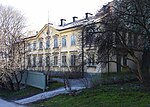Årstabroarna
Bridges completed in 1929Bridges completed in 2005Bridges in StockholmRail infrastructure in Stockholm CountyRailway bridges in Sweden

Årstabroarna (English: The Årsta bridges) are two parallel railway viaducts in central Stockholm, Sweden. Passing over the watercourse of Årstaviken and the islets Årsta holmar, they connect the major island Södermalm to the southern mainland district Årsta.
Excerpt from the Wikipedia article Årstabroarna (License: CC BY-SA 3.0, Authors, Images).Årstabroarna
Strandpromenad Årstaviken, Stockholm Södermalm (Södermalms stadsdelsområde)
Geographical coordinates (GPS) Address Nearby Places Show on map
Geographical coordinates (GPS)
| Latitude | Longitude |
|---|---|
| N 59.309166666667 ° | E 18.043888888889 ° |
Address
Östra Årstabron (Gamla Årstabron)
Strandpromenad Årstaviken
118 42 Stockholm, Södermalm (Södermalms stadsdelsområde)
Sweden
Open on Google Maps








